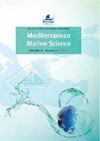Small-scale fishery catch composition in Rhodes (Eastern Mediterranean Sea)
IF 2.3
3区 环境科学与生态学
Q1 MARINE & FRESHWATER BIOLOGY
引用次数: 0
Abstract
Trammel net and boat-seine experimental fishing samplings were carried out seasonally, over a rocky-sandy and a Posidonia oceanica habitat respectively, in the coastal waters of Rhodes, south-eastern Aegean Sea, Greece, between 2019 and 2020. Fish catch composition, abundance and biomass were investigated as a contribution to the qualitative and quantitative monitoring of the fish assemblages in the artisanal fishery in this Greek marine region most affected by biological invasion. A total of 56 native and 11 alien fish species were captured. Five invasive species Fistularia commersonii, Pterois miles, Siganus rivulatus, Siganus luridus and Lagocephalus sceleratus were recorded using both fishing gear. In trammel nets, the alien to native fish species ratio was 1:2.87 with eight allochthonous species composing 43% of the total abundance and greatly exceeding native species biomass with the most dominant being F. commersonii, P. miles, S. rivulatus and S. luridus. Boat seine samples were dominated by Spicara smaris and Boops boops, which accounted for 84% and 56% of total abundance and biomass, respectively, while the alien to native fish species ratio was 1:5.1. The 10 Lessepsian fish, i.e., fish that have entered the Mediterranean Sea via the Suez Canal, identified on a Posidonia seabed represented a small proportion of the total abundance (3.4%), while their biomass reached 17% of the total catch, with a prevalence of F. commersonii. Among alien fish on P. oceanica, S. rivulatus exhibited the greatest abundance, followed by F. commersonii, Parupeneus forsskali and S. luridus, with small but not negligible densities of Pteragogus trispilus and Torquigener flavimaculosus. The abundance of Pterois miles over the rocky-sandy habitat was remarkable. Results indicate a transitional shift in fish catch composition with introduced species competing with natives for food and space (i.e. between introduced siganids and Sparisoma cretense, Sarpa salpa, between the recently introduced P. forsskali and mullids, and between introduced P. miles and scorpaenids), further influenced synergistically by environmental and anthropogenic factors. The Total-Standard length and Total weight-Total length relationships and their applications in fisheries data for the allochthonous fish are briefly discussed.罗得岛(东地中海)小型渔业的渔获量构成
2019 年至 2020 年期间,在希腊爱琴海东南部罗得岛沿岸水域的岩石沙地和 Posidonia oceanica 栖息地,按季节分别进行了桁架网和船式围网试验性捕捞采样。对鱼类的捕获组成、丰度和生物量进行了调查,以促进对这一受生物入侵影响最严重的希腊海洋地区个体渔业中鱼类组合的定性和定量监测。共捕获了 56 种本地鱼类和 11 种外来鱼类。两种渔具都记录到了五种外来入侵物种:Fistularia commersonii、Pterois miles、Siganus rivulatus、Siganus luridus 和 Lagocephalus sceleratus。在三层刺网中,外来鱼种与本地鱼种的比例为 1:2.87,8 种外来鱼种占总丰度的 43%,大大超过本地鱼种的生物量,其中最主要的是 F. commersonii、P. miles、S. rivulatus 和 S. luridus。船围网样本中主要是 Spicara smaris 和 Boops boops,分别占总丰度和生物量的 84% 和 56%,外来鱼种与本地鱼种的比例为 1:5.1。在 Posidonia 海床上发现的 10 种 Lessepsian 鱼类(即通过苏伊士运河进入地中海的鱼类)只占总丰度的一小部分(3.4%),而其生物量则达到总捕获量的 17%,其中以 F. commersonii 为主。在大洋石首鱼上的外来鱼类中,S. rivulatus 的数量最多,其次是 F. commersonii、Parupeneus forsskali 和 S. luridus,Pteragogus trispilus 和 Torquigener flavimaculosus 的数量也很少,但不可忽视。在岩石沙质生境中,Pterois miles 的数量非常可观。结果表明,随着引进物种与本地物种争夺食物和空间,鱼类捕获量的组成发生了过渡性变化(即引进的鮨科鱼类与 Sparisoma cretense、Sarpa salpa 之间,最近引进的 P. forsskali 与鲻科鱼类之间,以及引进的 P. miles 与蝎科鱼类之间),并受到环境和人为因素的协同影响。本文简要讨论了总长-标准长度和总重-总长的关系及其在同源鱼类渔业数据中的应用。
本文章由计算机程序翻译,如有差异,请以英文原文为准。
求助全文
约1分钟内获得全文
求助全文
来源期刊

Mediterranean Marine Science
MARINE & FRESHWATER BIOLOGY-
CiteScore
5.20
自引率
17.90%
发文量
34
审稿时长
>12 weeks
期刊介绍:
The journal Mediterranean Marine Science (MMS), published by the Hellenic Centre for Marine Research (HCMR), issues three volumes annually. The journal welcomes original research articles, short communications, New Mediterranean Biodiversity records, extended reviews, comments, and Theme sections in all fields of Oceanography, Marine Biology, Marine Conservation, Fisheries and Aquaculture in the Mediterranean area and the adjacent regions. All content is peer reviewed.
 求助内容:
求助内容: 应助结果提醒方式:
应助结果提醒方式:


